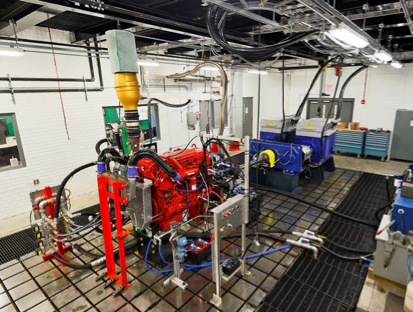
ORNL’s Advanced Vehicle Systems research program provides key expertise in the understanding, simulation, and integration of advanced vehicle technologies to offer new insight on the potential benefits for hybrid electric, plug-in hybrid electric, and other advanced powertrain vehicles.
The Vehicle Systems Integration (VSI) Laboratory offers unique capabilities to evaluate and simulate engines, electric motors, and transmissions in conventional and hybrid powertrain configurations for vehicles ranging from light-duty cars to Class 8 trucks. The VSI Laboratory enables accelerated powertrain development by performing prototype research and characterization of advanced propulsion systems on a sub-system and/or component level. The VSI Lab features an “X”-in-the-loop experimental platform for evaluating components or subsystems in a virtual vehicle environment. For instance, hybrid drive systems commissioned in the VSI powertrain test cell comprise an engine (with or without emission aftertreatment) and transmission including electric machines and power electronics; a virtual environment with modeling of driveline, vehicle characteristics, and energy storage system with battery management controls; and actuators comprising twin dynamometers coupled through a summing gearbox and an energy storage system emulator.
Capabilities allow users the flexibility to change vehicle architectures virtually and to simulate factors such as aerodynamics, load, grade, and traffic. By combining actual and virtual systems, the laboratory captures accurate, real engine and aftertreatment measurements, ensures the repeatability of a controlled transient operating environment, and offers cost savings and increased safety compared to on-road or on-track analysis.
R&D Focus Areas
- Powertrain systems integration
- Interfacial relationships among individual powertrain components
- Analysis of transient phenomena including thermal effects and emissions
- Evaluation of advanced component technologies in a vehicle systems context
- Development of practical energy management strategies
- Holistic strategy development encompassing emissions reduction and fuel efficiency tradeoffs
- Understanding how vehicles are bounded by powertrain limitations and performance expectations
- Development of evaluation procedures and standards applicable to individual components and integrated powertrain systems
Equipment Highlights
- Twin 500-kW ac transient dynamometers capable of up to 3,750 N∙m torque
- Acceleration/deceleration rates of up to 3,500 rpm/s
- Summing gearbox capable of linking dynamometers for powertrain applications, providing up to 20,000 N∙m torque
- 400 kW (up to 800 V and 600 A) energy storage emulator with stand-alone flexibility to simulate and evaluate different energy storage systems
- dSPACE hardware-in-the-loop real-time platform for vehicle and subsystem emulation
- Dual transient emissions measurement system for criteria emissions and particulate matter
- 250-kW low-inertia double-ended dynamometer capable of up to 650 N∙m torque and 12,000 rpm

